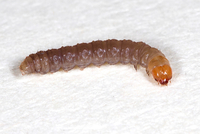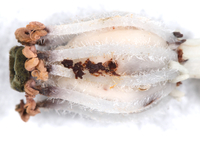Taxonomy
Family: Subfamily: Tribe: P3 Number: MONA Number:
Comments: Paralobesia is a genus of small tortricid moths, with the majority of species found in the Nearctic Region. Royals et al. (2019) recently completed a much-needed revision of the genus, which now includes 43 species. Only 19 species were described prior to their work, and there appear to be a few remaining undescribed species in North America where there is insufficient material or data to formally describe them (Royals et al., 2019). We currently have 12 described species in North Carolina, as well as one undescribed species (J.B. Sullivan, pers. comm.). Many are very similar in external coloration and patterning, and are best identified using either genitalia or rearing from host-specific plants.
Identification
Adult Markings: The following description is primarily from that of Royals et al. (2019). The vertex is pale reddish-brown and the labial palps pale-brown to reddish-brown. The second segment of the palp is rough scaled, while the third is smooth scaled. The thorax is mottled with reddish-orange and tan scales and the posterior crest is mottled with dark-brown and orange scales. Paralobesia such as P. liriodendrana and is best confirmed by either rearing the adults or using genitalia or DNA barcoding.
Forewing Length: 4.2-5.2 mm (Royals et al., 2019).
Adult Structural Features: Royals et al. (2019) have descriptions and illustrations of the male and female genitalia.
Genitalia and other structural photos
Adult ID Requirements: Identifiable only by close inspection of structural features or by DNA analysis.
Immatures and Development: The larvae mostly feed on Indian Pipe. Royals et al. (2019) noted that the first instar larvae enter the developing ovary through the pistil, then feed on the interior ovary tissue. They do not feed on the seeds, but will feed on stem pith if the ovary tissue is completely consumed. Jim Petranka found larvae in Indian Pipe flower heads in Madison County. The larvae fed on the ovary tissue, and a bore hole was made where frass was deposited outside on the ovary. Larvae that were reared exited the fruits and pupated in faint silk cocoons along the edges of the zip-lock bag, with the adult emerging after about two weeks. The older instars were rather nondescript with light dirty-gray bodies and a light amber-colored heads. The prothoracic shield was slightly lighter than the body color, but otherwise similar.
Larvae ID Requirements: Identifiable from good quality photos, especially where associated with known host plants.

 »
»



 »
»

